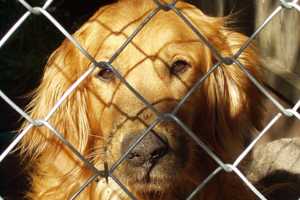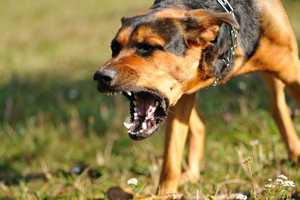Dogs
 Many studies show the health benefits of dog ownership. Dogs not only provide comfort and companionship, but several studies have found that dogs decrease stress and promote relaxation. Dogs have positive impacts on nearly all life stages. They influence social, emotional, and cognitive development in children, promote an active lifestyle, and have even been able to detect oncoming epileptic seizures or the presence of certain cancers. But for all the positive benefits of keeping dogs, pet owners should be aware that dogs can carry germs that make people sick.
Many studies show the health benefits of dog ownership. Dogs not only provide comfort and companionship, but several studies have found that dogs decrease stress and promote relaxation. Dogs have positive impacts on nearly all life stages. They influence social, emotional, and cognitive development in children, promote an active lifestyle, and have even been able to detect oncoming epileptic seizures or the presence of certain cancers. But for all the positive benefits of keeping dogs, pet owners should be aware that dogs can carry germs that make people sick.
Although germs from dogs rarely spread to people, they might cause a variety of illnesses, ranging from minor skin infections to serious disease. To protect yourself and your family from getting sick:
- Seek routine veterinary care for your pet and
- Always wash your hands and the hands of children with running water and soap after contact with dogs, their stool, and their food.
By providing your pet with routine veterinary care and some simple health tips, you are less likely to get sick from touching, petting, or owning dogs in the United States.
Click the tabs above for more information about choosing dogs, a list of diseases people can get from dogs, and information on how to keep yourself and your pet dogs healthy.
The most common diseases associated with dogs that can cause human illness are:
Campylobacteriosis (Campylobacter spp.)
Campylobacter spreads through contaminated food (meat and eggs), water, or contact with stool of infected animals. Dogs infected with Campylobacter might show no signs of illness at all or might have diarrhea and a slight fever.
Most people who become sick with campylobacteriosis will have diarrhea, cramping, abdominal pain, and fever within 2-5 days after exposure to the organism. Campylobacter can cause serious life-threatening infections in infants, older persons, and those with weakened immune systems.
Dog Tapeworm (Dipylidium caninum)
The dog tapeworm is a parasite spread to dogs, cats, and people through the ingestion of infected fleas. This parasite is common but rarely causes illness in pets or people. Infections with Dipylidium caninum can sometimes be detected by finding rice-like segments of the tapeworm crawling near the anus or in fresh bowel movements. In severe infections, pets can lose weight and have mild diarrhea.
In people, children are more commonly infected but don't usually show signs of disease. The best way to prevent infection in pets is to control the flea population in the environment.
Hookworm (Zoonotic) (Ancylostoma caninum, Ancylostoma braziliense, Uncinaria stenocephala)
Dog hookworms are tiny worms that can spread through contact with contaminated soil or sand. Dogs can also become infected with hookworms through accidentally ingesting the parasite from the environment or through their mother's milk or colostrum. Young puppies are most often affected and might have dark, bloody stool and anemia. Severe infections in some puppies can lead to death.
People become infected with dog hookworms while walking barefoot, kneeling, or sitting on ground contaminated with stool of infected animals. Hookworm larvae enter the top layers of skin and cause an itchy reaction called cutaneous larva migrans. A red squiggly line might appear where the larvae have migrated under the skin. Symptoms usually resolve without medical treatment in 4-6 weeks.
Rabies
Rabies, a fatal neurologic disease in animals and people, is caused by a virus. Animals and people are most commonly infected through bites from rabid animals. Infected dogs might have a variety of signs, but most often have a sudden behavioral change and progressive paralysis. Rabies is prevented by vaccination.
The first symptoms in people can start days to months after exposure and include generalized weakness, fever, and headache. Within a few days symptoms will progress to confusion, anxiety, behavioral changes, and delirium. If you have been bitten by a dog or other animal and feel that there is a risk for rabies, contact your health care provider right away. Once symptoms appear, it is almost always too late for treatment.
Roundworm (Toxocara spp.)
Toxocara roundworms cause a parasitic disease known as toxocariasis. Dogs and people can become infected by accidentally swallowing roundworm eggs from the environment. In addition, larval worms can cross through the placenta, milk, or colostrum of a mother dog, passing the infection to her puppies. Infected puppies usually do not develop and grow well and might have a pot-bellied appearance.
In people, children are most often affected with roundworm. There are two forms of the disease in people. Ocular larva migrans happens when the larvae invade the retina and cause inflammation, scarring, and possibly blindness. Visceral larva migrans occurs when the larvae invade parts of the body, such as the liver, lung, or central nervous system.
Less common diseases associated with dogs that can cause human illness are:
Brucellosis (Brucella spp.)
Brucellosis is a bacterial disease that affects the ability of animals to reproduce. The disease can be transmitted to humans through contact with recently aborted tissue from infected animals or consumption of unpasteurized (raw) milk. Dogs that are infected might have decreased appetite, weight loss, behavioral changes, and lack of energy, but most dogs infected with brucellosis show no signs of illness. Brucellosis affects the reproductive organs and can cause early-term deaths of developing puppies.
People who are infected with brucellosis will usually become sick within 6-8 weeks of exposure. Sick people will have flu-like symptoms that last 2-4 weeks. Sometimes brucellosis can become a chronic illness that can be difficult to treat.
Capnocytophaga spp.
Many species of Capnocytophaga bacteria live in the mouths of dogs and cats. These bacteria do not make dogs or cats sick.
Rarely, Capnocytophaga can spread to people through bites, scratches, or close contact from a dog or cat and cause illness. Most people who have contact with a dog or cat do not become sick. People with weakened immune systems who have difficulty fighting off infections (for example, people with cancer or those taking certain medications such as steroids) are at greater risk of becoming ill.
Cryptosporidiosis (Cryptosporidium spp.)
Cryptosporidium is a parasitic disease that is transmitted through contaminated food or water from an infected person or animal.
Cryptosporidium illness in dogs is rarely seen, but they can carry the germ without showing any signs of illness.
Cryptosporidium can cause profuse, watery diarrhea with cramping, abdominal pain, and nausea in both animals and people. Illness in people is usually self-limiting and lasts only 2-4 days, but can become severe in people with weakened immune systems.
Echinococcosis (Echinococcus spp.)
Echinococcosis is a parasitic disease caused by eating or drinking food and water contaminated with a specific type of tapeworm eggs or through contact with an infected animal. Dogs become infected by eating tissue of an infected animal. Dogs rarely show any signs of disease, but if they are infected with a large number of worms, dogs can have diarrhea and enteritis.
Although Echinococcus invades many different organs of the body, most people who are infected with the disease will not have any signs of illness for years. Symptoms start when the slow-growing cysts become large enough to press on the organs they have invaded. The tapeworms grow slowly in several different organs of the body, most commonly the liver and lungs.
Ehrlichiosis (Ehrlichia spp.)
Ehrlichiosis is a bacterial disease that affects animals and people and is transmitted by ticks. Dogs show variable signs that include depression, loss of stamina, stiffness and reluctance to walk, and coughing.
People show similar signs and symptoms, which include fever, headache, chills, muscle pain, nausea, vomiting, diarrhea, and rash.
Giardiasis (Giardia spp.)
Giardia is a parasite that causes diarrhea in animals and people. Giardia is transmitted to animals and people through food or water contaminated with stool.
Symptoms in animals and people include diarrhea, greasy stools, and dehydration. People can also have abdominal cramps, nausea, and vomiting. Symptoms can last 1-2 weeks.
Leishmaniasis (Leishmania spp.)
Leishmaniasis is a protozoan disease of people and animals. It is transmitted by sandflies and is uncommon in North America. The two forms of the disease are visceral and cutaneous. The cutaneous form of leishmaniasis is most common in people and appears as one or more painless ulcers on the skin. Visceral leishmaniasis is less common and is characterized by fever, weight loss, enlarged spleen, and anemia. Dogs can develop both forms at the same time and have a variety of symptoms.
Leptospirosis (Leptospira spp.)
Leptospirosis is a bacterial disease of people and animals that is transmitted through contaminated water and urine or other body fluids from an infected animal. It is difficult to detect early stages of leptospirosis in animals, but the disease can lead to kidney and liver failure if left untreated.
People who become infected with leptospirosis might not have any signs of the disease. Others will have nonspecific flu-like signs within 2-7 days after exposure. These symptoms usually resolve without medical treatment, but can reappear and lead to more severe disease.
Lyme Disease (Borrelia burgdorferi)
Lyme disease is a bacterial disease of people and animals transmitted by ticks. In dogs the most common signs of illness of Lyme disease are lameness, fever, reluctance to eat, lack of energy, and enlarged lymph nodes, with or without swollen, painful joints.
Infected people will typically have a red "bull's eye" rash at the site of the tick bite that appears about 7 days after being bitten. Flu-like symptoms quickly follow the rash. If not treated, this disease can spread to other parts of the body and cause symptoms such as arthritis and loss of facial muscle tone (Bell's palsy). Lyme disease can be fatal.
MRSA (Methicillin-Resistant Staphylococcus aureus)
Staphylococcus aureus is a common type of bacteria that is normally found on the skin of people and animals. Methicillin-resistant Staphylococcus aureus (MRSA) is the same bacterium that has become resistant to some antibiotics. Dogs and other animals often can carry MRSA without being sick, but MRSA can cause a variety of infections, including of the skin, respiratory tract, and urinary tract.
MRSA can be transmitted back and forth between people and animals through direct contact. In people, MRSA most often causes skin infections that can range from mild to severe. If left untreated, MRSA can spread to the bloodstream or lungs and cause life-threatening infections.
Pasteurellosis (Pasteurella spp.)
Pasteurellosis is a bacterial disease associated with animal bites and scratches. Pasteurella is a normal bacterium that lives in the mouths of healthy dogs. The bacteria do not typically make dogs sick; however, dogs can develop abscesses or skin infections in places where they were scratched or bitten by another animal.
Pasteurella is found in 50% of patients with infected dog bite wounds. Pasteurella can cause painful wound and skin infections. In more severe cases, it can cause widespread infection and might even affect the nervous system.
Plague (Yersinia pestis)
Plague is a bacterial disease in animals and people that can lead to serious illness if left untreated. Dogs are unlikely to develop clinical disease if infected.
People most often become infected through flea bites or from contact with body fluids of infected animals. An example is a hunter skinning an infected rabbit or other animal. Bubonic plague is the most common form; symptoms include sudden onset of high fever, chills, headache, malaise, and swollen lymph nodes. The other two forms of plague, septicemic and pneumonic, cause more severe disease.
Ringworm (Microsporum canis)
Ringworm is a condition caused by a fungus that can infect skin, hair, and nails of both people and animals. Ringworm is transmitted from animals to people through direct contact with an infected animal's skin or hair. Puppies are most commonly affected and can have circular areas of hair loss anywhere on the body.
Ringworm infections in people can appear on almost any area of the body. These infections are usually itchy. Redness, scaling, cracking of the skin, or a ring-shaped rash may occur. If the infection involves the scalp or beard, hair may fall out. Infected nails become discolored or thick and may possibly crumble.
Rocky Mountain Spotted Fever (Rickettsia rickettsii)
Rocky Mountain spotted fever (RMSF) is a bacterial disease transmitted to dogs and people by ticks. Dogs show a variety of symptoms similar to those in people, including fever, lameness, coughing, vomiting and diarrhea, and swelling of the face or extremities.
People start showing signs 2-14 days after exposure; these may include fever, rash, headache, nausea, vomiting, abdominal pain, and muscle pain. RMSF can develop into a serious illness if not promptly treated.
Salmonellosis (Salmonella spp.)
Salmonella spreads to people through contaminated food (eggs and meat) or contact with stool of certain animals including dogs. Salmonella infections have been linked to some brands of dry dog food, treats, and chew toys like pig ears and to "raw food" diets for dogs. While it usually doesn't make the dogs sick, Salmonella can cause serious illness when it is passed to people.
People exposed to Salmonella might have diarrhea, vomiting, fever, or abdominal cramps. Infants, elderly persons, and those with weakened immune systems are more likely than others to develop severe illness.
Sarcoptic Mange (Sarcoptes scabeii), also known as Mange
Sarcoptic mange is a parasitic skin disease that is caused by a tiny mite. Mange is transmitted between animals through close contact. In dogs, the mite causes severe itching and self-inflicted wounds from scratching.
People can't become infested with the canine version of sarcoptic mange, but they can have a minor local reaction from the mites if they come in contact with an infested dog.
In this section
Healthy habits
CDC recommends hand washing whenever you play or work with dogs.

Person washing their hands with soap and water.
- Wash your hands with soap and running water after contact with dogs, dog saliva, or dog stool. Be sure to assist children with handwashing. Thoroughly washing hands will reduce the risk of disease transmission to people.
- Avoid bites and scratches from dogs. Dog bites might become seriously infected or might be a source of rabies. Be cautious with unfamiliar animals. Approach dogs with care, even if they seem friendly.
- Pick up and dispose of dog stools, especially in areas where children might play. Cleaning up after your dog will help keep the area clean and reduce the risk of spreading disease to people or other animals.
- Visit your veterinarian for routine evaluation and care to keep your dog healthy and to prevent infectious diseases.
Tips for preventing dog-associated diseases
Before choosing a dog
- Certain types of dog or puppy adoptions, like international pet adoption, might not be suitable for your family because of the risk for disease. This is particularly true if young children, pregnant women, or persons with weak immune systems are living in the household. Persons with weak immune systems may include the elderly or people with an illness such as diabetes or HIV/AIDS, or those undergoing chemotherapy.
- Research and learn how to properly care for your dog before purchase or adoption. Ask your veterinarian about the proper food, care, and environment that are best for the dog you are selecting.
- Be aware that dogs might shed Campylobacter, Giardia, hookworms, roundworms, and other germs in their stool. Plan to clean up after your pet frequently. Wash your and your child’s hands thoroughly with soap and water after feeding or cleaning up behind dogs.
Choosing a dog

Small dog.
- Match a dog’s attitude, temperament, size, and activity level with your family, your home, and the amount of time you have to spend with your pet.
- Pick a dog that is bright, alert, and playful. Dogs and puppies should have shiny, soft fur that is free of stool. Signs of illness in a dog include appearing sluggish or depressed, having diarrhea, abnormal breathing, and fluid running from its eyes or nose. Make sure to take your new dog or puppy to the veterinarian within a few days to a week after adoption for a health visit.
- If your dog becomes sick or dies soon after purchase or adoption, take your dog to the veterinarian promptly, and inform the pet store, breeder, or rescue organization about the pet’s illness or death. Make sure to tell your veterinarian if the pet was adopted internationally. Thoroughly clean the area occupied by your pet, and consider waiting at least a few weeks before purchasing or adopting another pet.
Housing your dog

Dog in a fenced yard.
- It is important that you provide a safe, warm, and comfortable environment for your dog to live in.
- If your dog will be housed outside, provide shelter such as a doghouse for when it is cold or rainy and shade for when it is hot. Protecting your dog from the changes in weather will reduce stress and help keep it healthy.
- Make sure your dog has access to fresh, clean water every day.
- Consider fencing in your yard rather than tying your dog outside. A fence will not only give your pet room to play, but also will protect it from wild animals and reduce the risk of strangers interacting with your dog. Several studies have shown that dogs on a chain are more likely to bite than those in a fenced yard.
- If your dog is in a kennel, make sure to clean it regularly to prevent build-up of feces and possible spread of disease.
Monitor your pet’s health

Veterinarian examining a dog.
- Visit a veterinarian for routine evaluation and care to keep your dog healthy and prevent infectious diseases. Keeping your dog on a monthly preventative for fleas, heartworms, and other parasites, and up to date on vaccinations can help prevent certain diseases.
- Make sure to clean up any urine, feces, or vomit in the house immediately, and disinfect the area well. Use disposable gloves and make sure to wash your hands thoroughly afterwards.
- Contact your veterinarian if you notice any signs of illness in your pet. Keep in mind that even a dog that appears healthy might spread germs to humans and other animals.
Dog bites
Preventing dog bites

Dog in an aggressive stance showing teeth.
About 4.5 million Americans receive dog bites each year, many of which require immediate medical attention. Young children 5 to 9 years old are most likely to bitten by dogs, with boys being bitten more often than girls.
Dog Bite Prevention. Follow these tips to prevent dog bites.
What to do if you are bitten or scratched by a dog
Germs can be spread from dog bites and scratches, even if the wound does not seem deep or serious. If a bite from a dog occurs, you should—
- Wash wounds with warm soapy water immediately.
- Seek medical attention:
- If you don’t know if the dog has been vaccinated against rabies
- If the dog appears sick or is acting strangely
- If the wound is serious (uncontrolled bleeding, loss of function, extreme pain, muscle or bone exposure, etc.)
- If the wound becomes red, painful, warm or swollen, or if you develop a fever
- If it has been more than 5 years since your last tetanus shot
- If you have any concerns about your or your child’s health
- Report the bite to your local animal control or health department.
- If possible, contact the owner and ensure the animal has a current rabies vaccination. You will need the rabies vaccine license number, name of the veterinarian that administered the vaccine, and the owner’s name, address, and phone number.
- Due to the risk of rabies, ensure that the dog is seen by a veterinarian and contact your local health department if it becomes sick or dies within 10 days of the bite.
Publications and Materials
Brochures
Selecting a Dog
American Veterinary Medical Association
Websites
Preventing ticks on your pets
CDC
Be a Responsible Dog Owner
American Kennel Club
Dog Bites
Fact sheet. CDC
Podcasts
People Can Catch Diseases from Their Pets
CDC
Staying Safe Around Dogs After a Disaster
CDC
Helpful books and references
Kirton A, Wirrell E, Zhang J, and Hamiwka L. Seizure-alerting and-response behaviors in dogs living with epileptic children. Neurology 2004; 62: 2303-2305. Accessed Feb 2014: http://www.neurology.org/content/62/12/2303.full.html
Nonfatal Dog Bite-Related Injuries Treated in Hospital Emergency Departents – US, 2001
Morbidity and Mortality Weekly Report. July 4, 2003 / 52(26);605-610.
Pickel D, Manucy GP, Walker DB, Hall SB, and Walker JC. Evidence for canine olfactory detection of melanoma. Appl Anim Behav Sci 2004;89:107-16.
- Page last reviewed: July 14, 2016
- Page last updated: July 14, 2016
- Content source:


 ShareCompartir
ShareCompartir